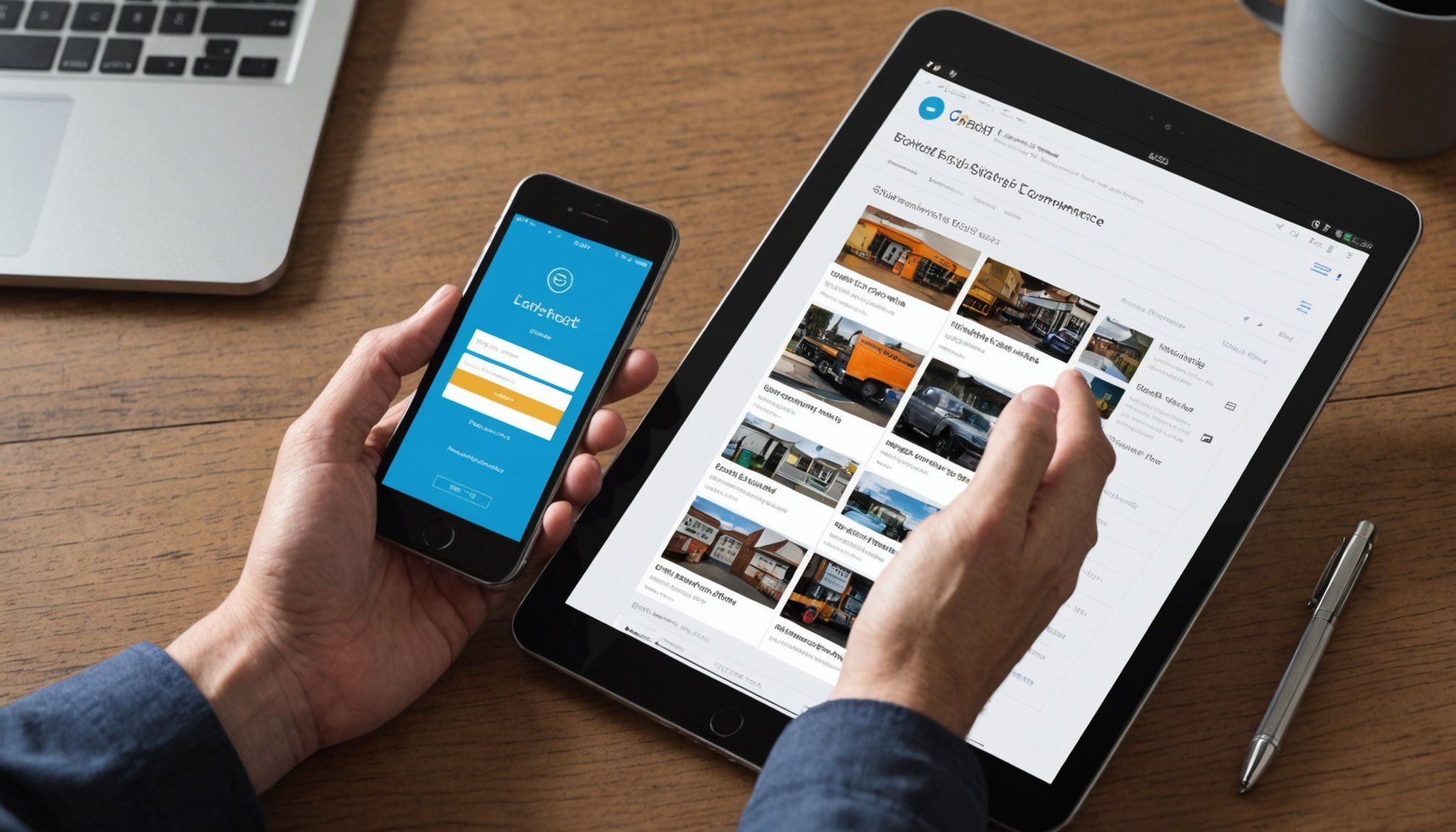Importance of Mobile-Friendliness for Bristol Ecommerce Businesses
In the era of digitalisation, mobile-friendly ecommerce has become a key factor for Bristol businesses aspiring to thrive in a competitive market. With a growing trend towards mobile commerce, it’s essential for local businesses to adapt to the ever-evolving consumer habits. The ability to provide a seamless user experience on mobile devices significantly impacts customer retention and satisfaction.
Consumers in Bristol rely heavily on their smartphones to shop, making it imperative for ecommerce platforms to be optimised for mobile use. When websites are not mobile-friendly, users are likely to leave, resulting in lost potential sales. This underscores the importance of ensuring that mobile usability meets the expectations of today’s tech-savvy shoppers.
This might interest you : Supercharge your client campaigns: harnessing ai for marketing excellence at a sheffield agency
Statistics reveal a compelling story: businesses that prioritise mobile usability see notable benefits. For instance:
- 70% of online interactions occur on mobile devices.
- Mobile-friendly sites witness a 67% increase in sales conversions.
- 50% of users abandon sites that aren’t mobile-optimised within just 10 seconds.
For Bristol businesses, embracing mobile-friendly ecommerce is not merely an option but a necessity. By focusing on delivering a top-notch user experience, businesses can build customer loyalty and boost their market presence in the dynamic world of mobile commerce.
Also to read : The ultimate blueprint for launching telemedicine in uk healthcare clinics: uncovering crucial steps for success
Key Components of a Mobile-Friendly Ecommerce Site
In today’s fast-paced digital world, a responsive design is crucial for any ecommerce website seeking mobile accessibility. This approach ensures that a website automatically adjusts its layout based on the screen size of the device being used, whether a smartphone, tablet, or desktop. By doing so, businesses cater to the increasing number of consumers shopping via mobile devices.
A primary benefit of responsive design is the use of flexible layouts and images, which significantly enhance user experience. Flexible layouts allow a website to maintain its visual appeal and functionality regardless of the screen size, ensuring that users do not face issues like content overlap or distorted visuals. Moreover, flexible images scale appropriately, preventing slow load times or pixelation, which are common frustrations for mobile users.
Intuitive navigation is another key component of a successful ecommerce website. Users expect to find information quickly and easily; hence, a well-designed menu and search bar are essential. Having clear, thumb-friendly buttons and streamlined paths for users makes the shopping experience more enjoyable and efficient. By focusing on these key components, businesses can meet and exceed user expectations, ultimately driving more sales through mobile platforms.
Enhancing Loading Times for Mobile Users
Improving fast loading times is crucial for maintaining user engagement, particularly on mobile devices. One of the most effective strategies is optimizing image size and compression. Large images can significantly slow down website performance, so using formats like JPEG and WebP, with appropriate compression levels, helps maintain quality while decreasing file size.
Another key practice is minimizing HTTP requests which can be achieved by consolidating stylesheets and scripts. Every HTTP request adds to the loading time, especially on mobile where connections can be slower. Leveraging browser caching allows frequently used resources to be stored locally, reducing the need for repeated network requests and improving response times.
To truly optimize for website performance, it’s essential to use tools that measure current loading speeds and identify areas for improvement. Tools such as Google PageSpeed Insights or GTmetrix provide insights into performance metrics and actionable suggestions. Techniques like lazy loading for off-screen images also contribute to speed by loading only visible content, ensuring a seamless experience for mobile users.
Implementing these strategies not only enhances mobile optimization but also boosts user satisfaction, potentially increasing the likelihood of return visits. All these techniques together ensure a rich, fast, and efficient web experience.
Mobile Optimization Strategies
Designing for mobile is no longer optional—it’s crucial. Mobile optimization is about ensuring your website and content cater to those accessing it from handheld devices. A key aspect is the mobile-first design, where designers prioritize the mobile experience over desktop. This approach includes streamlined navigation, which enhances the user’s journey and keeps them engaged.
To boost user engagement and lower bounce rates, it’s essential to implement effective content layout. Properly structured content should be easy to read, with concise paragraphs and strategically placed headers. Simplifying navigation through clear menus and categorization can also help users find what they need without frustration, improving their overall experience.
An indispensable factor is accessibility. Websites must cater to users with varying needs, adhering to standards like larger text for readability and intuitive interfaces for screen readers. Furthermore, considering touch-friendly interfaces is vital. This includes ample button sizes and spacing, as well as incorporating responsive interactive elements such as carousels or collapsible menus.
Content should load quickly and function smoothly regardless of device capabilities. These strategies not only enhance the user experience but can also lead to improved rankings on search engines aiming to prioritize mobile-friendly sites.
User Interface Tips for Mobile Commerce
When designing for mobile ecommerce, focus on creating a streamlined checkout process. This involves ensuring key elements like forms and payment gateways are simple and intuitive. Reducing the number of steps in the checkout process can increase conversions, as mobile users often seek fast and seamless experiences. Implementing guest checkout options and integrating autofill capabilities simplify the procedure, enhancing user satisfaction.
Next, consider the importance of clear calls-to-action (CTA). These should be prominently displayed and easy to locate for the user. Utilising bold colours and strategic placement ensures users understand the next step, guiding them effectively through their purchase journey. CTAs should be concise and direct, encouraging users to proceed without hesitation.
Visuals play a pivotal role in mobile design by capturing users’ attention and emphasizing product offerings. Micro-interactions, such as subtle animations or hover effects, can further elevate usability by providing feedback or affirmation of user actions. These small, interactive features contribute to a more engaging and satisfying user experience, making the ecommerce platform not only functional but also enjoyable. By prioritising these elements, mobile commerce platforms can significantly enhance their user interface and overall performance.
Local SEO Considerations for Bristol Ecommerce
For Bristol businesses, local SEO is a crucial aspect of digital marketing strategy. Focusing on optimising for local keywords that are relevant to the Bristol area is paramount. This involves tailoring content to include location-specific terms that resonate with local searches. Not only does this help in reaching the right audience, but it also increases your business’s visibility in local search results.
To achieve higher visibility in mobile search results, it’s essential that your website is mobile-optimised. Given that a significant number of local searches are conducted on mobile devices, ensuring a seamless mobile user experience can enhance your ranking. Responsive design, fast loading times, and easy navigation are key components to consider.
Incorporating local business listings and Google My Business can significantly bolster your promotion efforts. Creating and maintaining a comprehensive Google My Business profile is instrumental in appearing in local search and map results, offering potential customers vital information about your business at a glance.
Together, these strategies can effectively position your e-commerce venture within the local Bristol market, attracting more customers who are specifically searching for what you offer. By implementing these methods, businesses can efficiently compete within their local environment.
Tools and Resources for Building Mobile-Friendly Sites
Creating a mobile-friendly ecommerce site requires utilising specialised resources and tools to enhance functionality and ensure optimal site performance.
Website Builders and Platforms
Selecting the right website builder is crucial for establishing a mobile-responsive ecommerce presence. Popular options include Shopify, Wix, and Squarespace, each offering templates and mobile tools to ensure flexibility and adaptability across devices. These platforms provide integrated solutions to simplify ecommerce resources management, enabling businesses to efficiently sell online without extensive coding knowledge.
Performance Testing Tools
Utilising performance testing tools is essential for maintaining optimal site speed and responsiveness. Tools like Google PageSpeed Insights and GTmetrix evaluate your site’s performance, offering insights into load times and potential areas for improvement. This proactive approach ensures that users enjoy a seamless experience, which is critical for retaining customers and enhancing conversions.
Analytics and Tracking Solutions
Incorporating robust analytics and tracking solutions, such as Google Analytics, is vital for understanding user interactions and site performance metrics. By analysing this data, businesses can identify trends and areas requiring improvement. Tracking solutions provide valuable insights, enabling continuous optimization of mobile-friendly features and ultimately improving the user’s journey. These strategies collectively foster a successful ecommerce platform that meets evolving customer needs.
Case Studies of Successful Mobile-Friendly Ecommerce Sites in Bristol
In exploring the realm of mobile ecommerce in Bristol, several local businesses stand out for their exceptional strategies and implementation. Successful businesses like “Eco-Living Bristol” and “Bristol Vintage Finds” have harnessed the power of mobile-friendly platforms to captivate their audience and drive sales.
Key Takeaways from Successful Businesses
-
User-Centric Design: These case studies reveal the importance of a seamless and intuitive user interface. Mobile optimisation ensures that customers enjoy a smooth shopping experience, crucial in retaining and converting users.
-
Responsive Layouts: A key element in their triumph is having adaptable layouts that work on different screen sizes, improving accessibility and convenience for their mobile users.
-
Efficient Checkout Process: Streamlining the purchase process by reducing unnecessary steps has proven instrumental. Click-to-buy and auto-fill forms are effective tools.
Guiding New Ecommerce Entrepreneurs
For aspiring ecommerce entrepreneurs in Bristol, these examples offer invaluable insights. Emulating successful strategies, such as prioritising mobile optimisation and investing in responsive designs, can empower newcomers to thrive in the competitive digital marketplace. Adopting these best practices equips them to meet modern consumer expectations, enhancing engagement and satisfaction.











